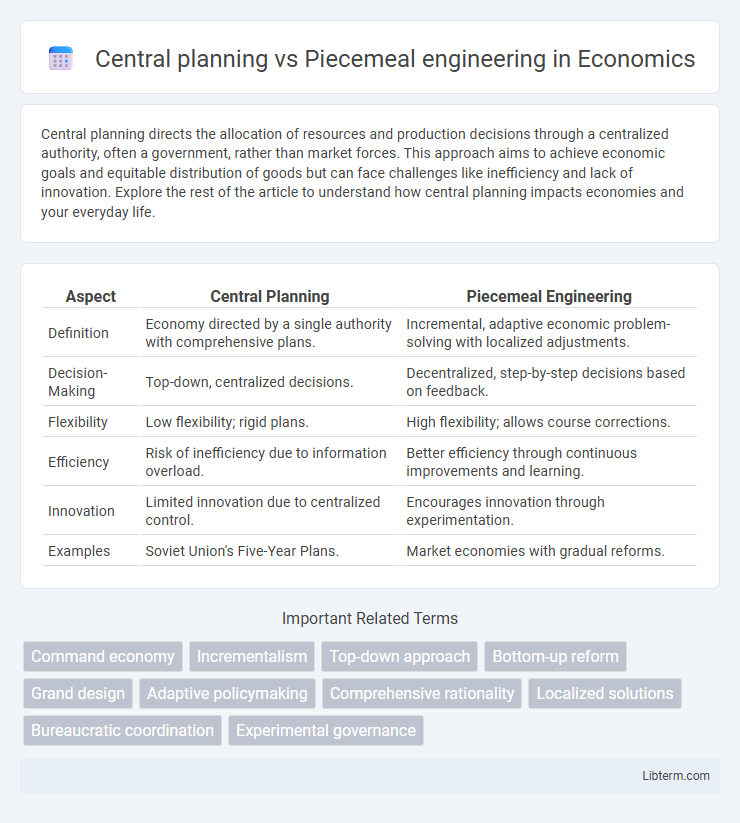Central planning directs the allocation of resources and production decisions through a centralized authority, often a government, rather than market forces. This approach aims to achieve economic goals and equitable distribution of goods but can face challenges like inefficiency and lack of innovation. Explore the rest of the article to understand how central planning impacts economies and your everyday life.
Table of Comparison
| Aspect | Central Planning | Piecemeal Engineering |
|---|---|---|
| Definition | Economy directed by a single authority with comprehensive plans. | Incremental, adaptive economic problem-solving with localized adjustments. |
| Decision-Making | Top-down, centralized decisions. | Decentralized, step-by-step decisions based on feedback. |
| Flexibility | Low flexibility; rigid plans. | High flexibility; allows course corrections. |
| Efficiency | Risk of inefficiency due to information overload. | Better efficiency through continuous improvements and learning. |
| Innovation | Limited innovation due to centralized control. | Encourages innovation through experimentation. |
| Examples | Soviet Union's Five-Year Plans. | Market economies with gradual reforms. |
Introduction to Central Planning and Piecemeal Engineering
Central planning involves a comprehensive, top-down approach where a centralized authority makes coordinated decisions to shape complex systems or economies, aiming for cohesive outcomes through detailed blueprinting. Piecemeal engineering relies on incremental, localized improvements driven by trial-and-error and practical problem-solving, emphasizing flexibility and adaptability over grand design. These contrasting methodologies highlight the balance between control and emergent order in managing large-scale projects or social systems.
Defining Central Planning: Principles and Practices
Central planning relies on a comprehensive framework where decisions are made based on an all-encompassing, top-down approach to design and coordination. It emphasizes systematic control, resource allocation, and harmonization of components to achieve overarching objectives efficiently. Key principles include unified goals, detailed upfront specifications, and continuous oversight to maintain alignment with the central strategic vision.
What is Piecemeal Engineering? Core Concepts Explained
Piecemeal engineering refers to an incremental, adaptive approach to system design where changes are made in small, manageable steps rather than through a comprehensive, centralized plan. Core concepts include iterative development, localized problem-solving, and continuous feedback integration, enabling flexibility and responsiveness in complex environments. This contrasts with central planning by prioritizing modular improvements and emergent solutions over rigid, top-down directives.
Historical Context and Key Proponents
Central planning emerged prominently during the Soviet era, advocated by economists like Leon Trotsky who emphasized state control over resources to achieve rapid industrialization. In contrast, piecemeal engineering was championed by economist Friedrich Hayek, stressing decentralized decision-making and the limits of central knowledge. Historical context reveals the clash between these approaches during the 20th century's ideological and economic struggles, shaping debates on efficiency and innovation.
Comparative Analysis: Strengths and Weaknesses
Central planning excels in providing a cohesive vision and coordinated resource allocation, ensuring large-scale projects align with overarching goals but often suffers from rigidity and slow adaptability to changing conditions. Piecemeal engineering allows for rapid innovation and localized problem-solving by focusing on incremental improvements, yet it may lead to fragmented systems and lack unified direction. The optimal approach balances the strategic oversight of central planning with the flexibility and responsiveness of piecemeal engineering to maximize efficiency and innovation.
Case Studies: Real-World Applications of Both Approaches
Central planning drove the Soviet Union's industrialization, showcasing the benefits of coordinated resource allocation but suffering from inefficiencies and rigidity. In contrast, piecemeal engineering underpinned the development of the internet, where incremental innovation and decentralized decision-making enabled rapid adaptation and scalability. These case studies highlight central planning's strength in large-scale mobilization versus piecemeal engineering's advantage in flexibility and responsiveness to complex, evolving challenges.
Impact on Economic Growth and Innovation
Central planning often stifles economic growth and innovation by limiting competition and resource allocation flexibility, resulting in inefficient industries and slower technological advancement. In contrast, piecemeal engineering encourages decentralized decision-making, fostering experimentation and adaptive learning that drive dynamic market responses and accelerated innovation cycles. Empirical studies highlight economies with market-based systems outperform centrally planned ones in GDP growth and patent generation, reflecting the robust impact of decentralized innovation on long-term economic development.
Social and Political Implications
Central planning often concentrates decision-making power in a few hands, potentially limiting diversity of thought and innovation, which may lead to political rigidity and social dissatisfaction due to lack of responsiveness to local needs. In contrast, piecemeal engineering emphasizes decentralized, incremental problem-solving, fostering community engagement and adaptability, enhancing social cohesion and political pluralism. The choice between these approaches significantly influences governance structures, citizen participation, and the capacity for social change.
Lessons Learned: Failures and Successes
Central planning often results in inefficiencies and rigid structures that stifle innovation, as historically seen in large-scale government projects with excessive resource allocation and delayed outcomes. Piecemeal engineering allows for incremental improvements and adaptability, demonstrated by successful technology companies that implement iterative development and rapid prototyping. Lessons learned indicate that balancing strategic oversight with flexible, modular execution enhances overall project success and reduces the risk of costly failures.
Conclusion: Choosing the Right Approach for Modern Challenges
Central planning enables coherent, large-scale coordination but can lack flexibility in dynamic environments, while piecemeal engineering offers adaptability through iterative improvements tailored to immediate needs. The optimal approach for modern challenges balances strategic foresight with modular implementation, leveraging data-driven insights to adjust plans in real time. Organizations that integrate centralized vision with decentralized execution achieve superior innovation and resilience in complex, fast-changing markets.
Central planning Infographic

 libterm.com
libterm.com